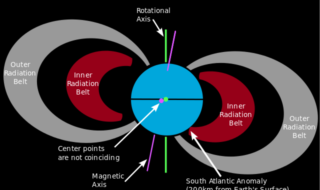The Van Allen belts are two radiation belts. These are zones of electrically charged particles which are poised, encompassing the Earth far above the surface, and held there by the planet’s magnetic field. The first of the belts was discovered in early 1958 through data collected by Explorer I (the United States’ first space satellite) and the Explorer III and Pioneer satellites, under James Alfred Van Allen and his team at the University of Iowa.
Similar radiation belts have since been found surrounding other planets, but the term of Van Allen belts only refers to those two belts (and sometimes other belts that are transitorily formed) which surround the Earth. They have been dubbed the Van Allen belts after the American physicist credited with their discovery.
Each of the two belts surrounds the Earth in a sort of doughnut-shaped formation. The inner belt reaches from approximately 600 to 3,000 miles above the Earth, and the outer belt from about 9,300 to 15,500 miles above the Earth. Astronomers have determined that the belts consist of many electrically charged particles, like protons and electrons. Earth’s magnetic field traps these particles, directing them to the magnetic poles.
The particles move in spiral paths along a system of flux lines, curving from the north magnetic pole to the south magnetic pole. As the particles come nearer either pole, the converging flux lines reflect them toward the opposite pole. This effect keeps the particles of the Van Allen belts bouncing between the poles. The belts receive new particles from the solar wind, a continuous stream of charged particles emitted from our sun.

Other particles can be gained by solar flares and cosmic rays. Intense solar activity can disrupt the belts, leading to magnetic storms. Such disruptions also affect radio reception, cause surges in power lines, and produce auroras.
Ever since their discovery, the Van Allen belts have concerned and inspired people’s minds. Hollywood feature film and TV producer, writer, and director Irwin Allen came out with his science fiction movie Voyage to the Bottom of the Sea in 1961, three years after the discovery of the first belt. The main plot conceived by Allen and Charles Bennett revolves around saving all life on Earth from the natural inferno that was created when a meteor shower pierced the Van Allen radiation belt, catching it ablaze.
Ice burgs begin to melt in the Arctic, entire forests are engulfed in flames, and the crews of sea-going vessels traveling on the ocean’s surface are baked alive. Eventually, scientist Admiral Harriman Nelson proposes to shoot a nuclear missile from his submarine Seaview into the burning belt at a certain projection and time, which would, in theory, overwhelm and extinguish the skyfire, essentially “amputating” the belt from the Earth.

Even today, decades later, people are concerned about the radiation belts. A prominent group of physicists wants the belts eliminated altogether. A plan was even suggested in which long conducting tethers that are charged with a high voltage are deployed from satellites into the belts. It would force charged particles that come into contact with the tethers to have their pitch angle altered.
Over time, theoretically, this would dissolve the inner belts. The belts pose certain difficulties and dangers (mainly caused by radiation) whenever a satellite, telescope, or human is to be launched into outer space. There is a decent scientific argument in that these belts provide anything useful, or that we could do away with them without a negative effect.
According to some, if the belts were not there, the Earth would no longer possess a magnetic field. That means that cosmic ray particles would be at liberty to collide with our atmosphere in larger quantities, resulting in a higher background level of secondary “air shower neutrons”, leading to higher doses of background radiation on the surface. If the Van Allen belts were gone, it would definitely impact human life.
Other sources:
The World Book Encyclopedia Vol. 20. World Book, Inc., 1987.






